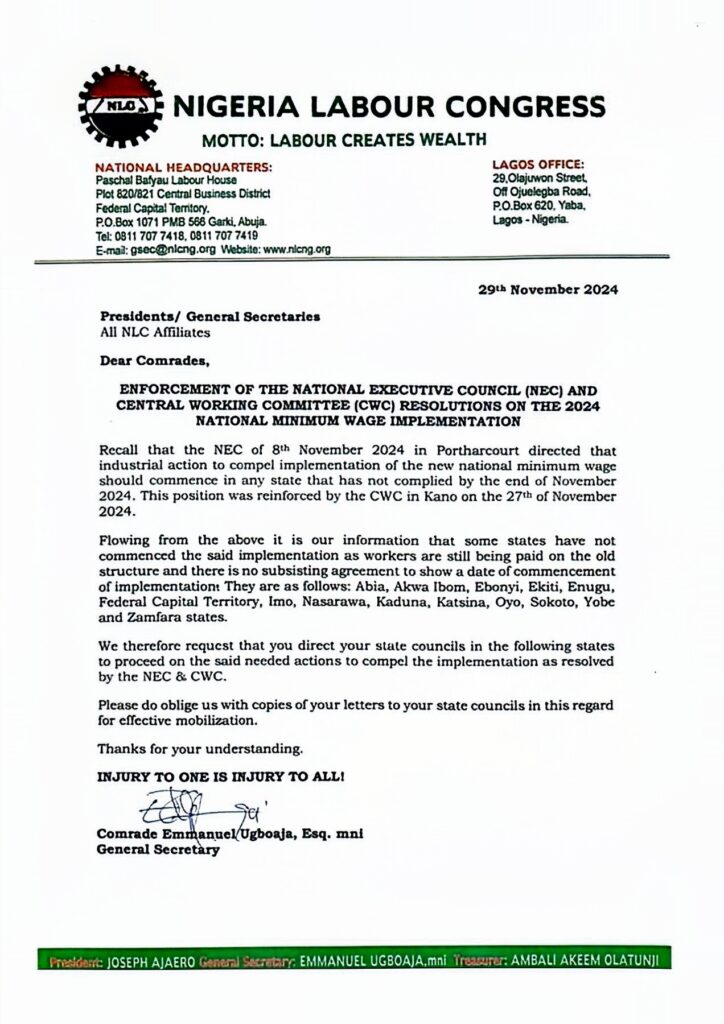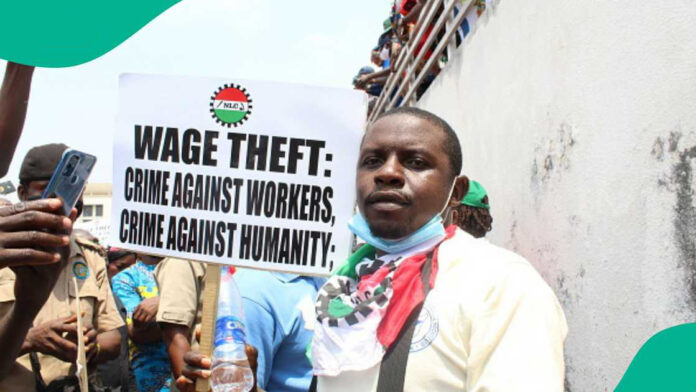Introduction
Strikes were organised in five states and the FCT at the end of November and early December 2024 and some definite gains were achieved. The minimum wage is now generally being implemented much earlier than was the case with the ₦30,000 minimum wage in 2019. In several cases, the consequential adjustments are better than for the previous increase. But for several states the ₦70,000 minimum wage is not to be implemented until 2025 and there is no agreement on payment of arrears from July 2024 in several states.
All state governments have far more money than they had in 2019. The monthly allocations of oil money are at record levels and Internally Generated Revenue (IGR – local taxes fees etc) is also now much higher. In addition, the minimum wage of ₦70,000 is very modest and can buy far less than the old minimum wage could buy in 2019. As a result, it would have been much easier for all states to afford to have generously implemented at least ₦70,000 from the end of July 2024, as legally obliged to do. This explains why several states have agreed to pay minimum wages of above this figure.
The dispute was already winning before the strikes started, as many more states are now implementing the new minimum wage earlier than was the case in 2019 (Zamfara State only implemented the N30,000 minimum wage earlier in 2024, Nasarawa State only implemented the consequential adjustment for GL7 and above in June 2024). Strikes were held in Cross River, Ebonyi, Kaduna, Nasarawa, Zamfara States and the FCT. But within just over two weeks all the states had settled and it is not really clear that they won many significant victories. This paper is an attempt to explain why these strikes did not win more and what is needed to ensure clearer victories in future.
Winning strikes is all about confidence
If workers are confident that they can win they are more likely to win. If the governors think the tide is on their side they are more likely to hold out against giving concessions. These state level strikes needed regular congresses and mass protests with full and public support from the national level of the trade unions to achieve victory.
After a series of general strikes had been called off by the national NLC, after little more than 24 hours, confidence in the leadership of the NLC had been dented. This was made worse by the leadership of the NLC and the TUC giving the government three gbosas for awarding a minimum wage of only ₦70,000 (when the expectation was that we could win at least ₦100,000).
After seeing the national leadership accept the implementation date being shifted from the beginning of May to the end of July, trade union leaders in some states have accepted further postponements of payment of the new minimum wage to December, January or even later. Time will tell whether states actually implement the agreements they signed – some state governors have already reneged on their agreements.
The dominant view was that the country had economic problems, so we all had to tighten our belts until the condition improved and life would get better for everybody. This appeared to be true as most trade union members were suffering significant economic hardship. But in reality both Federal and state governments had never had so much money. This needed to be confirmed by clear statements from the NLC nationally.
The oil money allocations for 2024 were 45% higher than the year before (and that was a record year). As a result, many states could spend more than half their expenditure on capital projects when half of this amount would have been very high by international standards. In addition, many states have huge balances of unspent funds in their bank accounts.
The general strike organised by the NLC in Kaduna State in May 2021 demonstrated clearly how a general strike, even against the most powerful of opponents, can be won, in a matter of days. The State was completely closed down, including the airport, banks, schools and public sector offices and the electricity was shut off. Street protests led by the NLC national President were held on a daily basis and the strike was headline news in the national media every day. El Rufai, then one of the most powerful governors, was defeated within three days (although he was later allowed to re-gain some of his power).
National strike plans were rolled out late
The minimum wage was signed into law on 29th July, 2024, the National Salaries, Wages and Revenue Commission issued its templates on consequential adjustments on 23rd September. But the NLC did not really issue its strike plans until later in November.
The fifth item of the NLC Communique from its NEC meeting of 8th November was:
The NEC therefore resolves to set up a National Minimum Wage Implementation Committee that will among others commence a nationwide assessment, mobilization and sensitization campaign, educating workers and citizens on the need to resist this assault on their dignity and rights. Furthermore, the NLC shall initiate a series of industrial actions in all non-compliant states and shall not relent until the minimum wage is fully implemented across Nigeria.
To this end, all state Councils where the National Minimum Wage has not been fully implemented by the last day of November, 2024 have been directed to proceed on strike beginning from the 1st day of December, 2024.
Subsequently, the Central Working Committee met in Kano on Wednesday 27th December. The NLC General Secretary then issued a letter on Friday 29th November. The following 14 states were named: Abia, Akwa Ibom, Ebonyi, Ekiti, Enugu, Federal Capital Territory, Imo, Nasarawa, Kaduna, Katsina, Oyo, Sokoto, Yobe and Zamfara states. Cross River State was not mentioned, despite holding a two day warning strike in the two days before the CWC meeting.
The General Secretary’s letter mentioned implementation not being commenced and agreements to pay the new minimum wage. So allowed strikes to be immediately suspended if an agreement with a state was signed. This was significantly different from the NEC motion that talked about full implementation. The letter did not mention key aspects of mobilisation and organisation of the strike – as a minimum regular protests, town hall meetings and congresses. Similarly the importance of good media briefings was not mentioned.

Opportunities for NLC to organize nationally
As the strikes were starting in some states in the first week of December, the NLC Harmattan School was held in Abuja. Joe Ajaero, the NLC President, was reported as describing 2024 as the most challenging for workers in the country. Several delegates from the striking states attended the NLC School and mentioned that the strikes were discussed in the plenary sessions, but the opportunity did not appear to be taken to use this meeting to organise the strikes in any detail.
Joe Ajaero was also reported as saying the “Rich people are growing fatter on masses’ sweat” on 10th December at the 2024 delegates’ conference of the NLC Youth Council in Abuja. But no report indicated that the strikes in the states were mentioned at this meeting.
The NLC established a National Minimum Wage Implementation Committee consisting of members of its National Administrative Council and officers from the NLC national headquarters. The Committee robustly engaged the striking states and urged them to dutifully discharge the instructions by Congress organs. But this Committee was not able to send senior officials of the NLC to the different states to provide support and solidarity. Detailed guidance was not developed for the NLC State Councils.
When Should New Minimum Wage be paid from?
Legally, the National Minimum Wage (Amendment) Act, 2024 should have come into force on the date the Act was assented to by the President (29th July). However, the Minister of State for Labour, Nkeiruka Onyejeocha announced at the May Day celebrations in Eagle Square that the new minimum wage would be paid from 1st May, once it had been agreed.
The NLC nationally did not provide guidance on when the new minimum wage should be paid from nor on the requirement for arrears to be paid back to July. As a result, some states agreed for the minimum wage to be paid from December or even into 2025. Salaries for primary teachers and others in the FCT are not to be paid until January, for example. Workers in Zamfara State are not due to receive the new minimum wage until March 2025.
Consequential adjustments
The National Salaries, Wages and Revenue Commission issued its templates on consequential adjustments on 23rd September. This provided for a salary for any workers on GL1, step 1 of ₦77,500 (as increases had already been announced for the minimum salary of Federal workers to be at least ₦77,000). This indicated a percentage salary increase of 158%. Percentage increases for those on higher grades, as had also happened in 2019, were lower. So for GL7 it was 100%, GL10 70% and for senior staff on GL14 it was only 16%.
However, this template was not adopted by at least some of the states. In Katsina a worker on GL7 will now get at least ₦16,000 less than a Federal worker on the same grade; someone on GL10 will get ₦33,000 less a month and for someone on GL17 they will receive ₦229,000 a month less than a Federal worker. In Nasarawa State the template attached to the agreement with the NLC will mean that a worker on GL7 will loose ₦34,000 a month and someone on GL10 will loose ₦44,000 compared with the Federal figures.
In some states the salary templates were not specified in the signed agreements with the NLC and in Kaduna State at least, the salaries actually paid were less than those agreed with the trade union. The NLC State Executive Council was to meet on 23rd December to discuss this issue.
What happened with strikes in individual states?
Akwa Ibom – the NLC State Executive Council resolved to strike from Wednesday, 4th December at its meeting two days earlier, if an agreement was not signed with the state. The strike was delayed due to “the burial of the First Lady of our state”. An agreement to pay a new minimum wage of ₦80,000 starting from November 1, 2024 was signed on Tuesday, 3rd December so the strike was suspended.
The Governor then announced he was not implementing the agreement. However, the NLC/TUC Congress on Saturday 14th December voted through a unanimous vote to accept the Governor’s decision to pay the new minimum wage from January and a 13 month salary in December. The Governor wanted to complete the current staff verification exercise that the NLC accepted as being beneficial.
Cross River NLC organized a warning strike on 25/26th November, but then the indefinite strike for the following week was suspended. The State agreed to pay the new minimum wage with the December salaries, but no arrears were promised. The consequential adjustment was a “little bit reasonable and much better than before” according to an NLC official.
The State’s excuse for not paying workers more than ₦70k was huge debts from the time that Donald Duke was the Governor (1999 – 2007). Cross River does have the fifth highest debt of any state, but 80% of this debt is from the last five years. At the end of June the State had enough money in the bank to pay off a quarter of the debts so the debt is actually low.
At the end of 2023, the State had Pension and Gratuity Arrears of over ₦6 billion. This could easily have been paid with the money the State had at the end of the year (₦15 billion).
Ebonyi NLC commenced a one week warning strike on Monday 2nd December. The same day, the Governor threatened to dismiss striking workers who did not return to work within 72 hours. The President of the Nigeria Labour Congress, Joe Ajaero, on Tuesday (3rd December), described as irresponsible the threat by the Ebonyi State Governor to sack workers who embarked on strike over the non-implementation of the ₦70,000 minimum wage by the state government. The strike continued for a week and then negotiations were held over the implementation of the minimum wage.
Kaduna State – the strike was suspended after two days for government to revise its payment template, that NLC said had inconsistences. National Monitoring Committee “gave us the go-ahead to suspend the strike”. “The least-paid worker in Kaduna state received ₦72,000 in November,” according to Kaduna State Government.
Over 60% of the expenditure in the first 6 months was on capital. This is three times the amount spent on salaries etc. State income higher than claimed by the state government in the first half year.
Katsina State NLC signed agreement with the State Government on Friday 29th November. So no strike was held. The new minimum wage is to be implemented in December, but no mention of arrears in written agreement. GL7 gets ₦16k less than Federal Scale and GL10 ₦33k less so the consequential adjustment is less generous than the national template.
Nasarawa State NLC/TUC and Joint Public Service Negotiating Council organized a strike from 2nd December after a joint executive council meeting on the Thursday before the strike.The fourth of five NLC/TUC bulletins called for a congress for all workers on Friday, 13th December.
The strike was suspended on Monday 16th December after signing an agreement that day. The new minimum wage was to “come into operation from 1st December”. The previous minimum wage had not been fully implemented until at least June 2024 (despite a strike of nearly three weeks in June/July 2021 that concentrated on late promotions) and the consequential adjustment was not paid until June 2024 for those on GL7 and above. Full templates for implementation of the new minimum wage of ₦70,500 were attached to the signed agreement of December 2024.
Zamfara State – on Monday, 2nd December, a Memorandum of Understanding was signed as the outcome of a series of meetings held with the NLC that lasted for several days. The Government had finally accepted to start paying the ₦70,000 minimum wage with effect from March 2025 after a staff audit was completed. The indefinite strike that was scheduled to start that day was suspended.
FCT area councils – Strike began on 1st December. Secondary teachers went back to work on 10th December as they were paid their salary with the new minimum wage on the day before. Other workers and primary teachers returned to work on 12th December after a Memorandum of Understanding was signed with council chairs to pay minimum wage in January and five months arears (August – December) in February.
What was needed to win more?
More notice and detailed guidance should have been given to state NLC councils. The one page letter from the NLC General Secretary, two days before the proposed strike, on Friday 29th November was too little and too late.
National officers of the NLC and the TUC should have been touring the states that were on strike. They did not even visit Lafia, capital of Nasarawa State, that is only 2.5 hours away from Abuja despite a strike in December 2024 of over two weeks.
There should have been clear briefings and detailed guidance from the national NLC on how to organise the strike with regular town hall meetings and congresses and the need for maximum publicity.
The national trade union leadership needed to do more ensure that workers were mobilized for strike action. The task force usually set up by NLC and TUC to monitor compliance of the strikes in the states should be a moving and working task force and not a stationary one.
State NLC councils should have been encouraged to arrange daily protests and congresses to keep workers informed and raise the profile of the strike.
Clear guidance should have been provided by the national NLC on consequential adjustments, for states to accept the Federal template as a minimum. Similarly for the implementation date. As a minimum, states should have been paying the minimum wage from 29th July as required by law with arrears to be paid for later implementation.
Clear guidance was needed from the NLC nationally to ensure that all outstanding issues in the states were addressed and explicitly included in any agreements. This should have included, for example, any outstanding promotions, arrears of salaries, gratuity and pensions; and prompt payment of salaries on or before the 25th of each month.
State NLC councils should have been encouraged to research their state finances with templates from key states being prepared and shared by the NLC nationally. Workers need to be better briefed to answer false claims from some states, for instance Kaduna and Cross River.
State NLC councils needed more time to arrange finances for compliance monitoring, congresses and town hall meetings, media publicity etc.
NLC needs to develop clear and detailed guidance on how strikes can effectively be organised to ensure victory. This needs to be updated regularly and issued as necessary for state level strikes.
National NLC guidance and training is required for state Public Relations Officers to ensure that effective media coverage is achieved.
Clear guidance should be developed by the national NLC on good practice for staff verification exercises. These were used as an excuse to delay full implementation of the minimum wage in Akwa Ibom and Zamfara States, for example.
For more advice on what should have been done to fully implement the ₦70,000 minimum wage see the following flier: https://tinyurl.com/mr35hhbs
And this pamphlet: https://tinyurl.com/UnitySolidarity
Why are we still hungry?
In April 2019 when the minimum wage was increased to ₦30,000 it could buy 120kg of local rice sold loose. By May 2024, when the ₦70,000 minimum wage was agreed it could buy only a third as much, 43kg. In October, when the new minimum wage began to be introduced it could only buy 36 kg of local rice sold loose. In April, 2019 ₦30,000 would buy 200 litres of petrol. In May 2024 it could buy 100 litres, now it may not buy 65 litres.
A Case Study From Katsina State:
A Primary School teacher living in Katsina town will averagely spend this amount to survive with their family for a month. Assuming that the teacher has only one wife and four children.
Foodstuffs:
1. Rice 4 mudu – ₦20,000
2. Beans 4 mudu – ₦14,000
3. Maize – 10 mudu – ₦20,000
4. Spices – ₦5,000
5. Spaghetti 10 – ₦10,000
6. Macaroni – 5 – ₦5,000
7. Electricity Bill – ₦5,000
8. Water bill – ₦5,000
9. Health – assume no health complications in the family, just normal paracetamol, headache reliever, and catarrh capsules – ₦2,000
10. Fuel for motorcycle – ₦13,000 for 10 litres in a month
11. Monthly Islamiya bill for three children, assuming the last one is a baby that is not enrolled in school- ₦6,000
12. Recharge card and data subscription in a month – ₦5,000
Nothing less than N110,000 a month is needed to cover the above costs.
This assumes:
– no budget for new clothes for any of the family
– no plan for any savings
– no emergency case that may require money
– not paying rent, they own their house
– grandparents are not part of the family
– not paying any debt.
In the above analysis, there is nothing for any meat, eggs, milk, bread, fish or any luxury items.
The salary of GL 08/2 in Katsina State Civil Service was not up to ₦60,000 before the implementation of the new national minimum wage of ₦70,000. With the new minimum wage the teacher will receive ₦101,600, but this will be reduced as they now have to pay 7% (or just over ₦7,000) as a contribution to the pension scheme. This is still well less than their minimal needs calculated above.
Conclusions
As we have shown above, even with the full implementation of the new minimum wage and consequential adjustment, workers across Nigeria will be far poorer than they were just five years ago. The government increased the price of petrol by over 500% (this led to huge increases in the prices of goods and services generally). But it would not increase the salary of workers by as little as 150%. The new minimum wage is not enough to feed a family for a month and will inevitably lead to greater corruption, criminal activity and worse insecurity. We all have a role to play in changing this situation. We need to make the trade unions far more active and so successful at improving our salaries and working conditions.
We have to make sure that the trade unions are run far more democratically. We have to ensure that decisions on reaching agreements are made collectively with the maximum number of comrades directly involved. We need to get far better organized. We need groups of trade unionists who want to organize a serious fight to improve our lives to meet on a monthly basis with other Socialist Labour supporters in each state. We need to build a rank and file movement in each trade union – see: https://tinyurl.com/rank-file-move
This will give us the confidence we need to argue against trade union leaders who are too close to the government. We need a change of strategy to one that recognizes that we are in a serious class war. It is not enough to continually meet with government representatives and then sign agreements that are never implemented.
It is only the collective strength of trade unions, especially strikes that will make governments change their minds. Most governors know that they are looting from the public. We can only change this by threatening them and forcing them to pay the workers a living wage.
The objective of trade strikes should be to improve the salaries of trade union members and to improve their other conditions of service. Talks and negotiations with governments and their officials can only be a minor part of this process. It is collective action, primarily strikes, that can force governments to pay higher wages on time. Strikes have to continue until governments actually implement their agreements – our experience is that otherwise governments consistently fail to act on their signed agreements with trade unions.
Labour leaders must be compelled to call national and state strikes to renegotiate the wages of the workers. We can also achieve a total review of the pro-rich tax reforms and budget proposals. We need all trade union members who agree with this pamphlet to join us in this vital struggle. Join our Socialist Labour WhatsApp group by clicking on this link:
https://tinyurl.com/JoinSocialistLabour
Download the pdf version with the link below: https://socialistlabour.com.ng/wp-content/uploads/2025/01/States_strikes_December_20241.pdf






